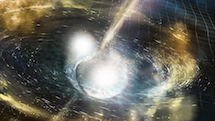Duncan Brown

Duncan Brown
Vice President for Research, Syracuse University; Charles Brightman Endowed Professor of Physics
CONTACT
Physics
263-1 Physics Building
Email: dabrown@syr.edu
Office: 315.443.5993
Degrees
- 2004 Doctor of Philosophy in Physics, University of Wisconsin-Milwaukee
- 1999 Master of Mathematics, University of Newcastle Upon Tyne
Social/Academic Links

Duncan Brown speaks to Vox Magazine about LIGO's discovery of a neutron star merger.
(Oct. 10, 2023)
Researchers from the University’s new Center for Gravitational Wave Astronomy and Astrophysics are at the intellectual center of the next-generation observatory.
(Sept. 25, 2023)
The new center officially launched with an opening ceremony featuring distinguished speakers from Harvard, MIT and Princeton.
(Sept. 27, 2022)
Duncan Brown, Charles Brightman Endowed Professor of Physics and Syracuse University’s Vice President for Research, will develop algorithms and computational techniques to advance gravitational-wave detectors of the future.
(Aug. 3, 2021)
Duncan Brown, the Charles Brightman Endowed Professor of Physics, is among a group of physicists who received a $3.25M NSF grant to study the properties of neutron stars.
(June 12, 2020)
Using observations of neutron star collisions, Professor Duncan Brown will study the nature of matter.
(Oct. 16, 2017)
Professors Saulson, Brown, Ballmer trace origins of gold and heavy metals to neutron star collisions
(Oct. 2, 2017)
Peter Saulson, Duncan Brown, and Stefan Ballmer played a lead role in the analysis of Gravitational wave signals as part of the multinational Laser Interferometer Gravitational-Wave Observatory (LIGO)
(June 1, 2017)
Alex Nitz G'15 helped detect gravitational-wave signal with software he began developing at Syracuse
(Oct. 13, 2016)
Physicist is leader in burgeoning field of gravitational-wave astronomy
(Aug. 19, 2016)
Professors Duncan Brown, Stefan Ballmer use NSF grant to help recruit, train students from underrepresented groups
(June 15, 2016)
LIGO detects second pair of colliding black holes
(May 25, 2016)
Gravitational Wave Group honored for contributions to physics, astronomy
(Feb. 11, 2016)
LIGO Opens New Window on the Universe with Observation of Gravitational Waves from Colliding Black Holes
(Feb. 11, 2016)
Finding coincides with 100th anniversary of Einstein's Theory of Relativity (VIDEO)
(Jan. 8, 2016)
Duncan Brown lauded for excellence in gravitational wave astronomy
(Sept. 17, 2015)
Physicists participate in first run of new Advanced LIGO Detector, after five-year rebuild
(May 27, 2015)
Physics department has been leading the search for gravitational waves for more than 25 years
Syracuse, Cal State Fullerton Awarded Grant to Enhance Diversity in Astrophysics
Syracuse Physicists among Recipients of Breakthrough, Gruber Prizes
Gravitational Waves Detected 100 Years after Einstein’s Prediction
Syracuse Physicist Named Brightman Endowed Professor
Syracuse Physicist Wins NSF Award to Advance Scientific Cyber-infrastructure
- Gravitational-wave astronomy and astrophysics.
- Searching for gravitational waves from compact binary coalesence in data from the LIGO and VIRGO observatories.
- Numerical relativity and its implications for gravitational wave detection.
- Third-generation gravitational-wave detectors.
- High-performance computing
- Research Corporation Scialog Fellow, 2015
- Fellow of the American Physical Society, 2014
- Cottrell Scholar, 2010
- Syracuse University Meredith Teaching Recognition Award, 2010
- Kavli Frontiers Fellow, 2009
- National Science Foundation CAREER Award, 2008
- Soares Santos M et al., The Electromagnetic Counterpart of the Binary Neutron Star Merger LIGO/Virgo GW170817. I. Dark Energy Camera Discovery of the Optical Counterpart, Astrophys J 848 L16 (2017)
- Cowperthwaite P S et al., The Electromagnetic Counterpart of the Binary Neutron Star Merger LIGO/VIRGO GW170817. II. UV, Optical, and Near-IR Light Curves and Comparison to Kilonova Models, Astrophys J 848 L17 (2017)
- Abbott B P et al., Multi-messenger Observations of a Binary Neutron Star Merger, Astrophys J 848 L12 (2017)
- Abbott B P et al., Gravitational Waves and Gamma-rays from a Binary Neutron Star Merger: GW170817 and GRB 170817A, Astrophys J 848 L13 (2017)
- Abbott Benjamin P et al., GW170817: Observation of Gravitational Waves from a Binary Neutron Star Inspiral, Phys Rev Lett 119 161101 (2017)
- Abbott Benjamin P et al., GW170814: A Three-Detector Observation of Gravitational Waves from a Binary Black Hole Coalescence, Phys Rev Lett 119 141101 (2017)
- Abbott Benjamin P et al., GW170104: Observation of a 50-Solar-Mass Binary Black Hole Coalescence at Redshift 0.2, Phys Rev Lett 118 221101 (2017)
- Abbott Benjamin P et al., The basic physics of the binary black hole merger GW150914, Annalen Phys (2016)
- Abbott B P et al., GW151226: Observation of Gravitational Waves from a 22-Solar-Mass Binary Black Hole Coalescence, Phys Rev Lett 116 241103 (2016)
- Abbott B P et al., GW150914: First results from the search for binary black hole coalescence with Advanced LIGO, Phys Rev D93 122003 (2016)
- Abbott B P et al., Observation of Gravitational Waves from a Binary Black Hole Merger, Phys Rev Lett 116 061102 (2016)
- Hannam Mark, Brown Duncan A, Fairhurst Stephen, Fryer Chris L, and Harry Ian W, When can gravitational-wave observations distinguish between black holes and neutron stars?, AstrophysJ 766 L14 (2013)
